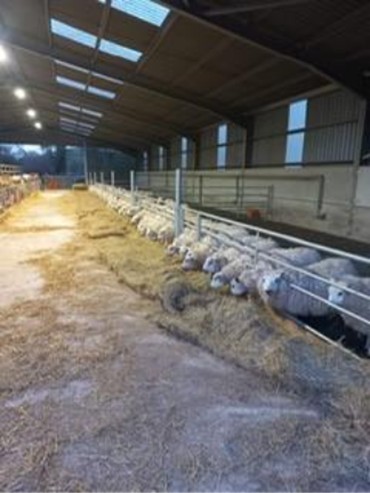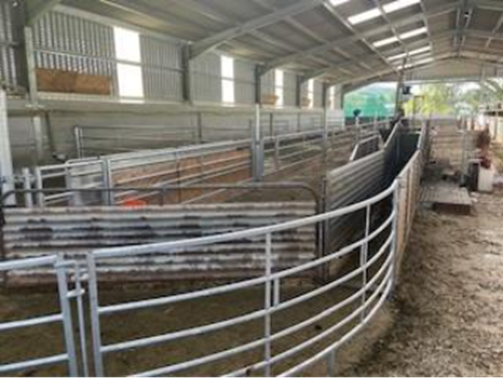Converting to Slatted Flooring for Improved Sheep Housing
29 October 2025Andrew Adamson was unsure how best to utilise a general purpose shed on his farm. A study trip to Ireland with his FAS Connect sheep group provided the insight and clarity he needed. Inspired by the systems he observed, Andrew decided to convert the shed into slatted accommodation for sheep, improving flock efficiency and welfare while also reducing bedding costs.
Netherurd Farm by The Numbers
- 626 acres.
- Beef, sheep, arable, and woodland enterprises.
- Finishing 190 cattle annually.
- Maintain 960 breeding Texel crosses from the Scotch Mule.
- Forestry and rental accommodation provide additional income.
- 30 acres of forage, 60 acres of cereal.
Andrew runs the family farm alongside his wife, Jayne and their two children, Hazel (15) and Jon (11). He is ably supported by Callum, a self-employed worker who has become an essential part of the team.
The Challenge
Limited shed space created seasonal pressures on the farm. In spring, cattle had to be sold early to make room for lambing ewes. In Autumn, sheep handling equipment had to be moved outdoors to allow cattle to be housed.
As a result, cattle were often sold before the reached their optimum weight and specification or outside of the desired marketing window. Likewise, the difficulty of aligning routine sheep handling tasks with available labour and favourable weather was becoming increasingly limited. This often resulted in work being carried out in poor conditions. A new shed was erected in 2020 for winter cattle housing and lambing overspill, but Andrew never felt it was being effectively utilised.
The Solution
On a farm visit to Northern Ireland in January 2025 with his FAS Connect Sheep Group, Andrew was inspired by an Irish farmer’s successful conversion of a former cattle shed into slatted accommodation for ewes over the winter. While Andrew had previously considered and disregarded plastic slats and manure tanks due to high costs, this visit demonstrated that there was a simpler and cheaper option available through the use of metal slates with a ‘dry’ manure system. Before the plane had touched down in Glasgow Andrew had a new system planned out, and construction began in February.
Implementation & Construction
Andrew designed a simple, low-cost blueprint with an efficient system for managing manure. Pen sizes were designed to accommodate up to 150 ewes and their lambs during handling sessions.
The shed, measuring 120 by 60 feet, with a solid concrete floor and cattle housing to one side was already in existence. The goal was to install a row of slatted sheep pens on the opposite side, with a feed passage wide enough to allow for easy handling of sheep outside of lambing season. To achieve this, the feed passage and pen area were excavated, and the passage was concreted, including 2 foot retaining walls to support the slats.
Metal mesh panels were chosen for the slats based on advice from Irish farmers, who found these helped the sheep to stay clean and the mesh was beneficial for maintaining sheep hoof health. Additionally, the mesh came in at a third of the cost compared to plastic slats. The mesh and wooden battens were purchased separately and assembled into panels by a local joiner.
The pens and panels were designed around standard material sizes to minimise labour and reduce the need for cutting. Each panel measures 16 by 4 feet and can be lifted by two people when they need lifted to muck the shed out, which Andrew anticipates will need done approximately every three years. The floor beneath the slats was left un-concreted to allow urine and dirty water to drain naturally, helping to reduce ammonia odours from waste buildup and extending the gap between mucking out.
The shed now consists of 4 pens, 32 x 16 feet with water bowls on the back wall and feed barrier to the front with each pen having a 2-foot access gate.
Final Costs
Andrew set a construction budget of £25,000 but slightly exceeded it, with final costs reaching £29,000. The overspend was primarily due to the addition of gale breakers, necessary to protect the shed from prevailing winds. The breakdown on costs is noted in the table below.
| Item | Cost |
|---|---|
| Groundworks | £5,000 |
| Concrete | £8,000 |
| Mesh panels | £3,500 |
| Wooden batons | £2,500 |
| Metal work (gates, barriers, columns etc) | £5,800 |
| Other ancillary items (water bowls etc) | £700 |
| Gale breakers | £3,500 |
Lambing System Overview
The normal procedure at lambing time is for sheep to be housed on straw during the night and turned out during the day. Pregnancy scanning identifies litter size and expected lambing dates, allowing ewes to be grouped into early or late lambing batches.
In 2025, 200 hoggs were lambed in the shed with individual lambing pens erected across from the slats.
Andrew quickly realised that the slatted pens needed to accommodate in excess of 22 hoggs in order to maintain pen cleanliness. The recommended space requirement for pregnant ewes is between 0.8 and 1.1 m² per ewe, and each pen can theoretically house between 43 and 59 hoggs. However, the feed barriers only allow 28 ewes to access forage at one time. This is a crucial limitation, as the sheep are fed ewe rolls once daily at the barrier, in addition to having access to ad-lib haylage. Feeding a total mixed ration (TMR) could allow numbers to be increased. Once the majority of the hoggs had lambed, the remaining ewes were brought into the shed.


All routine handling is now carried out within the shed using the existing Combi Clamp system, which is permanently set up with integrated weigh scales and an EID system. Sheep are guided into the system through a curved forcing gate leading from the slatted pens. Up to 550 ewes and their lambs can be handled in a day for dosing, vaccination, tailing, and foot bathing on exit.
Outcomes & Findings
This system has delivered numerous benefits:
- Andrew now has greater control over the sheep’s ration and feed intakes pre-lambing.
- The stress of bringing them in each night has been eliminated, resulting in improved maternal behaviour.
- There was a saving of approximately six tonnes of straw.
- Improved labour efficiency, both Callum, the seasonal lambing staff and local vets have commented on how well the system operates.
- The system has significantly improved sheep flow, enhancing time efficiency and reducing animal stress.
- Ease of cleaning has increased, and the handling passage can be washed down into the slats in under 20 minutes.
Future Plans
250 hoggs will be lambed in the shed next year alongside the main ewe lambing. Two students are employed for a three-week period to assist with lambing, so synchronising the lambing of hoggs and ewes will make more efficient use of this hired labour, compared to the usual system where hoggs are lambed after the students have finished.
Additional Benefits
Andrew has found several additional benefits to using the shed throughout the year, beyond routine handling sessions.
- Reduced finishing time by bringing any store lambs around 46kg liveweight into the shed for their final finishing period.
- Lambs stay cleaner and experience reduced levels of lameness compared to feeding outdoors.
- Frequently used for lairage and overnight housing before slaughter.
- Loading lorries has become more efficient as it can be done direct from pens.
Sign up to the FAS newsletter
Receive updates on news, events and publications from Scotland’s Farm Advisory Service
